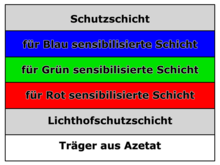Three-layer color film
The three -layer color film or three-layer film ( Integral Tripack) is a multi-layer color film . Such films were first introduced on the market in 1935 and 1936 respectively by the companies Kodak ( Kodachrome ) and Agfa ( Agfacolor-Neu ) .
In a three-layer ink film layers of the photographic emulsion, which consist of silver bromide - crystals and color couplers composed. The top layer is sensitized to blue light, the middle layer to green and blue, and the bottom layer to red and blue light. In the color developer, the top layer is yellow, the middle purple and the bottom blue-green.
Between the upper and the middle color-sensitized layer there is a filter layer, the "yellow filter barrier layer", which filters out the blue and violet components of the incident light.
Almost all reversal and negative color films have been structured in this way to this day . An exception was the Kodachrome film, which was produced until 2009 and does not require a color coupler; this causes a higher color stability, but the more complex development was only possible in specialized laboratories.
Structure of the layers

In the majority of all films produced today, there is a layer for each color (blue, green, red) with high, low and usually also medium light sensitivity. In addition, there is basically a yellow filter layer between the blue-sensitive layer and the green-sensitive layer, which is supposed to hold back blue light. This is necessary because the layers made green and red sensitive are not only sensitive to green and red, but like all photographic layers also to blue light. Often there is even a light red filter layer in front of the red-sensitive layer in order to achieve a more precise red sensitization and thus to bring about a purer blue and green reproduction.
When fully developed, the layers do not correspond to their color to which they are made sensitive, but to their complementary color. The blue-sensitive layer thus forms the yellow dye; so it is not blue, as the above diagram would suggest. The green-sensitive layer forms the purple dye and the red-sensitive layer forms the blue-green dye.
The Fujifilm company has added an additional layer to its films to protect against the color cast of fluorescent tubes.
Color negative films also normally contain a yellow-red to brownish color mask to compensate for the secondary densities of the dyes, which worsen the color fidelity. Secondary densities arise because there is no ideal sensitization for certain color components (blue, green, red) and ideal dyes (yellow, purple, blue-green), but these would be necessary for perfectly correct color reproduction. This mask is missing in color reversal films, as it would interfere with the projection due to its colourfulness.
literature
- Raymond Spottiswoode: Film and its techniques . University of California Press, Berkeley & Los Angeles 1968, pp. 211-213
- J. Bailey, LA Williams: The photographic color development process . In: K. Venkataraman (ed.): The chemistry of synthetic dyes , Vol. IV. Academic Press, New York 1971, pp. 341-349